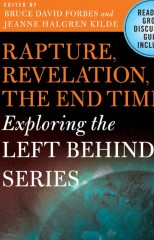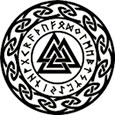
Authors : Forbes Bruce David - Kilde Jeanne Halgren
Title : Rapture, revelation, and the end times Exploring the Left Behind Series
Year : 2004
Link download : Forbes_Bruce_David_-_Kilde_Jeanne_Halgren_-_Rapture_revelation_and_the_end_times.zip
The Left Behind books by Tim LaHaye and Jerry B. Jenkins have now sold more than 60 million copies in their various forms. Based on one particular view of biblical prophecy, these books provide a fictional narrative of the end times: God has raptured his faithful church to heaven, and readers follow the struggles of a small group of belated converts as they battle the antichrist during the seven years of tribulation that precede Christ’s return in glory. Sold at Target, Wal-Mart, and Barnes & Noble, the series has reached well beyond conservative Christian audiences to the general public. In fact, the most recent volumes all have attained the number-one position in major rankings of bestselling fiction in the United States, even though those rankings do not include sales in Christian bookstores. Although these novels are fiction, they present a scheme of future events that the Left Behind authors believe to be biblically based. These writers believe that God will send his son, Jesus Christ, back to earth to finally conquer all sin and evil in a series of apocalyptic events that will shatter human society. Those who have previously become truly confessing Christians will be called to heaven in an event referred to as “the rapture” and thus spared the pain and horror of this apocalyptic period. This religious perspective, called “premillennial dispensationalism,” motivates all of the action, events, and relationships depicted in the series. On one level, the novels are intended as entertainment. They tell an exciting adventure story about people who convert to Christianity after the rapture and remain on earth to fight the antichrist. On another level, their religious message is central. For those who believe in the authors’ perspective, the novels demonstrate the high stakes at play in the process of religious conversion, affirming the crucial importance of devotion to Christ. Perhaps even more important, the books are intended to convince readers that in real life, Jesus’ return and the commencement of the end times may happen at any minute, so it is necessary to embrace immediately the particular style of Christianity represented in the books. In this vein, the novels are intended as a wake-up call for nonbelieving readers, a warning that time is short and that the consequences of putting off consideration of one’s salvation are eternal. Given the enthusiastic expressions of appreciation of these books on the Left Behind website and in conservative Christian circles throughout the world, it appears that many of the millions of readers of this series have embraced this particular message of conversion and salvation. These readers fully expect the rapture to happen in the near future and the apocalyptic events of Revelation to proceed. Many other readers, however, enjoy the adventure story but find the religious content curious or confusing. These readers understand that the series advocates a specific perspective on Christianity and society but feel ill-equipped to evaluate it. Many are frustrated that they do not have the knowledge of theology, biblical interpretation, or the history of Christian thought to fully appraise the religious perspective conveyed through the series. Numerous questions arise: Do all Christian groups share the theology that requires Christian conversion in order to avoid eternal damnation? Do all Christians believe that the Bible predicts that true Christians will be swept up to heaven prior to a period of unparalleled horror and tribulation on earth? How did the Left Behind perspective on these end times events develop? Why are other groups, particularly the Jewish people, included in the apocalyptic events? Why are so many social and political issues woven into these books? And, perhaps most interesting, just why have these novels gotten so popular? On what levels does it appeal to contemporary society? The goal of this “guide” is to answer these questions, providing the background and contextual information readers need to make their own critical assessments of the Left Behind series in particular and of end-times fiction and premillennial dispensationalism in general. By offering this material, the contributors to this volume hope to deepen readers’ understanding of the Left Behind series as both a religious and a cultural phenomenon. The essays are intended neither to advance nor to dispute the views of the end times presented in the series. Rather, the authors in this volume strive to provide readers with a balanced survey of the diversity of perspectives available on this subject. Several of the contributors summarize their own viewpoints, but they also try to be fair in discussing alternatives. Because religious beliefs intersect with many aspects of life, the chapters in this volume are written from several disciplinary perspectives. The study of popular culture and of literary genres is represented in chapters by Bruce David Forbes and Amy Johnson Frykholm, which focus on Left Behind’s popularity and its debt to the social and political themes common within religious fiction. The history of Left Behind’s perspective is examined by Jeanne Halgren Kilde, who traces the development of premillennial dispensationalism and millenarian thought through Christian history, and by Yaakov Ariel, who investigates the specific role assigned to the Jewish people within millenarian thought. New Testament scholar Mark Reasoner examines the interpretive position of the Left Behind authors, and theologian Stanley Grenz compares this interpretive position to other evangelical Christian perspectives. This multidisciplinary approach is meant to provide background, answer questions, and raise new areas of inquiry for readers’ further investigation. Bringing together these disciplines highlights some interesting differences among them regarding language use. For instance, readers will notice that while historian Kilde uses the term “premillennial dispensationalism,” evangelical theologian Grenz prefers “dispensationalist premillennialism.” This difference highlights the contrasting backgrounds of the authors, because different academic fields and different theological perspectives vary in their preferences in terminology. In another example, the term “proof text” is seen by some theologians as a pejorative label, while many historians and literary scholars use it as a neutral, descriptive phrase to denote one approach to biblical interpretation. In this collection, the editors have elected to allow each author to use the language with which he or she is most comfortable, in spite of the fact that this results in some inconsistencies. Readers should keep in mind these disciplinary differences. Readers’ questions form the foundation of this collection’s exploration of the series. In addition to questions that are addressed in the chapters themselves, a list of discussion questions is provided at the end of the book, to encourage personal reflection or to provide a guide for small-group discussion. But these are only a starting point. The authors of this book encourage readers to go beyond the basic issues presented here to think about how the religious, social, and political positions presented in the Left Behind series relate to their own values and views regarding religion and society. To aid in further inquiries, a book list appears at the end of this volume, offering suggestions for additional sources written from a variety of viewpoints. This book, then, is intended as a kind of “first stop” for readers attempting to fully understand the series in all its religious, social, and political implications. Answering some of the basic questions about Left Behind’s religious perspective, it provides tools readers require to make their own judgments about the religious messages embedded in the books and at the same time launches readers into several new and unexpected areas of inquiry. ...

Palmer Michael - Hiroshima revisited
Author : Palmer Michael Title : Hiroshima revisited The evidence that napalm and mustard gas helped...














